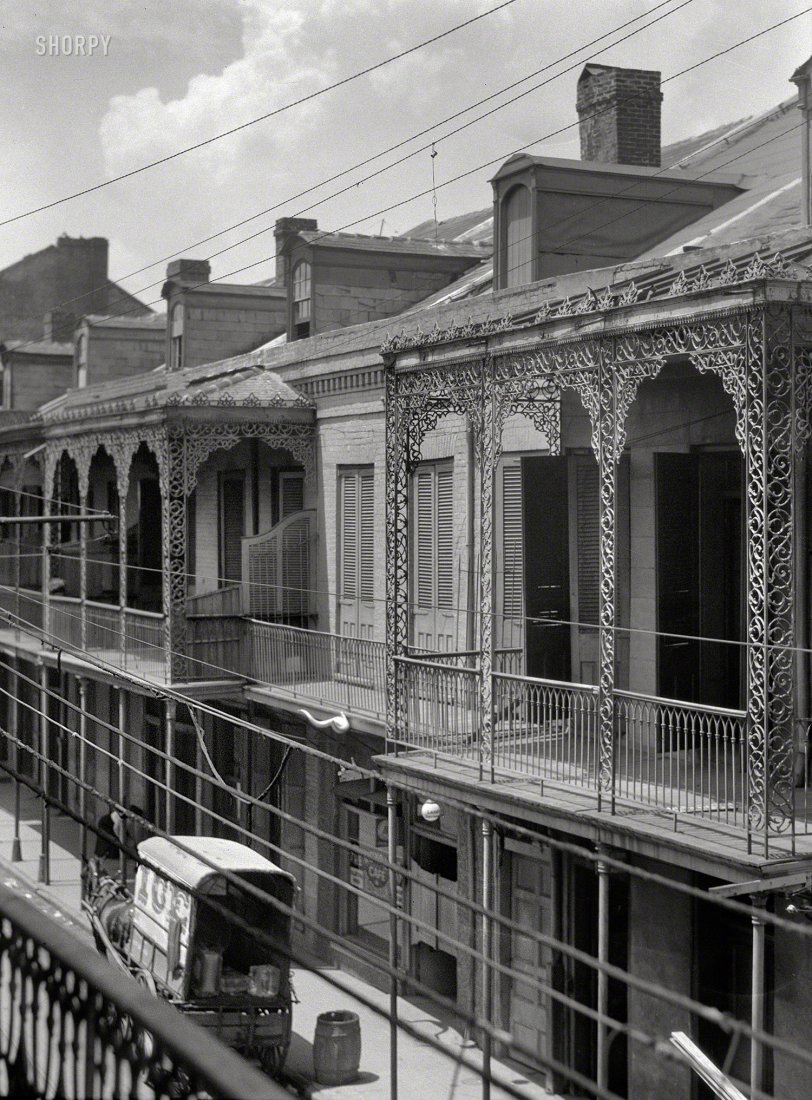


Framed or unframed, desk size to sofa size, printed by us in Arizona and Alabama since 2007. Explore now.
Shorpy is funded by you. Patreon contributors get an ad-free experience.
Learn more.

- Lofty addition
- In 1912
- Keenan Building
- Six years old
- Taken from the P.J. McArdle Roadway?
- It stood only 47 years
- Three track mind
- Incline to the right
- Reach for the sky, 1912 style
- No clean sweep
- Same Job Title, Same Face
- Sadly Lost
- Beautiful ...
- Where you get your kicks
- Aim High
- Pueblo Revival sisters
- Pueblo Neoclassicism
- Milk Man
- Regional dialect.
- Spielberg's inspiration
- Great Photo
- Loaf Story
- Do you still have the Rakes category?
- Could almost be a scene from the 1957 movie 'Hell Drivers'
- The Wages of Fear.
- Conspicuous by their absence
- Got Milk?
- All that aluminum
- No lefties
- Smoke 'em if you've got 'em
Print Emporium
The Ice Wagon: 1923

New Orleans circa 1923. "Upper stories of buildings with wrought iron balconies." 4x5 nitrate negative by Arnold Genthe. View full size.
Looks like a little Theft..
Looks like there is a home made "tap" of the utility going on (top center wires)Some one has thrown a weighted wire over the open wire and run it along the roof top. Still a common means of getting power south of the border and other poorer parts for the world.
Cast not wrought
Given the detail of the uprights and arched overheads, the railing system is most likely cast iron not forged wrought iron. By the late 1800's and into the early 1900's cast iron railings, and even whole building facades, were possible. Indeed, they took off in popularity primarily because they allowed for intricate designs that were too difficult to produce via forge work.
Looks just the same today
Except for the the ice wagon and above ground wires, this part of Royal St looks just the same today. View is of 1127, 1133, and 1135 Royal St photographed from the second floor balcony of the Lalaurie mansion (aka "the haunted house on Royal St").
Wonder where?
Wonder where the ice came from? I remember in the Northwestern Pennsylvania town of Stoneboro, harvesting ice from near-by Sandy Lake was a major industry. It was cut out in large blocks and stored on layers of straw in the town's ice house, to last often into the summer! I suppose they and other enterprising northern towns exported some as well.
[It would have been made locally in a commercial ice plant, the first of which opened in New Orleans in 1868. -tterrace]
Real (ICE) Men!
My paternal grandfather was an iceman. Born in 1890, he lived in the "Hell's Kitchen" area of NYC at 39th Street and 11th Avenue.
He plied his trade in this same area, and believe me, the buildings were a lot higher than the ones in this photo, and most had NO elevators back then, so he carried the ice up on his back.
Even after moving to Astoria, Queens, he worked long exhausting days, and well past his 65th birthday. I remember, as a small child, that after working all day, he would bounce me on his knee, and play with me, sometimes for hours.
As I sit typing this in my soft, cushy office, I can't help thinking that I wish I had half the character and strength this man had. RIP Grandpa!
























On Shorpy:
Today’s Top 5